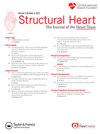Repeat Interventions After Transcatheter Aortic Valve Replacement: Clinical Characteristics and Outcomes of Redo Transcatheter Aortic Valve Replacement and Surgical Explants
IF 1.4
Q3 CARDIAC & CARDIOVASCULAR SYSTEMS
引用次数: 0
Abstract
Background
Transcatheter aortic valves (TAVs) are subject to degeneration and repeat intervention. TAVs are increasingly used in clinical practice, but there is a paucity of data regarding repeat interventions.
Methods
We sought to describe and compare clinical characteristics and outcomes of TAV in TAV procedures vs. surgical explant procedures after an index transcatheter aortic valve replacement (TAVR) at The Christ Hospital Health Network (Cincinnati, OH) from January 2015 to August 2023.
Results
A total of 1314 patients underwent TAVR procedures during the study period. Of these patients, 31 (2.3%) underwent repeat interventions (25 TAV in TAV and 6 surgical explants) and were included. The median [interquartile range] time from index TAVR to a repeat intervention was 5.02 years [1.01-7.12] for TAV in TAV and 2.55 years [1.36-3.20] for surgical explants (p = 0.386). Patients undergoing TAV in TAV were more likely to have structural valve deterioration (60%), whereas patients undergoing surgical explants were more likely to present with infective endocarditis (50%). Major adverse cardiovascular event rates were similar at discharge (20 vs. 17%, p = 1.00). No mortality events were presented in TAVR explant patients. Two strokes presented in TAVR explant patients, 1 at discharge and 1 at 30 days.
Conclusions
Repeat interventions are uncommon in the first decade after TAVR. In clinical practice, the mechanism of failure of the TAVR valve is an important determinant of subsequent treatment; most patients with structural valve deterioration receive a TAV in TAV procedure, whereas surgical explants are usually reserved for infective endocarditis.
经导管主动脉瓣置换术后的重复干预:重做经导管主动脉瓣置换术和手术移植的临床特点和结果
背景:经导管主动脉瓣(tav)易发生退变和反复介入。tav越来越多地用于临床实践,但缺乏关于重复干预的数据。方法:我们试图描述和比较2015年1月至2023年8月在基督医院健康网络(辛辛那提,OH)进行的经导管主动脉瓣置换术(TAVR)后TAV手术与外科外植体手术的临床特征和结果。结果研究期间共有1314例患者接受了TAVR手术。在这些患者中,31例(2.3%)接受了重复干预(25例TAV中TAV和6例手术移植)并被纳入。从TAVR指数到重复干预的中位数[四分位数范围]时间,TAV内TAV为5.02年[1.01-7.12],手术移植为2.55年[1.36-3.20](p = 0.386)。在TAV中接受TAV的患者更容易出现结构性瓣膜恶化(60%),而接受手术移植的患者更容易出现感染性心内膜炎(50%)。出院时主要不良心血管事件发生率相似(20% vs. 17%, p = 1.00)。TAVR移植患者无死亡事件。TAVR移植患者出现2次卒中,1次在出院时,1次在30天。结论TAVR术后10年内重复干预较为少见。在临床实践中,TAVR瓣膜失效的机制是后续治疗的重要决定因素;大多数结构性瓣膜恶化的患者在TAV手术中接受TAV,而外科移植通常用于感染性心内膜炎。
本文章由计算机程序翻译,如有差异,请以英文原文为准。
求助全文
约1分钟内获得全文
求助全文
来源期刊

Structural Heart
Medicine-Cardiology and Cardiovascular Medicine
CiteScore
1.60
自引率
0.00%
发文量
81
 求助内容:
求助内容: 应助结果提醒方式:
应助结果提醒方式:


